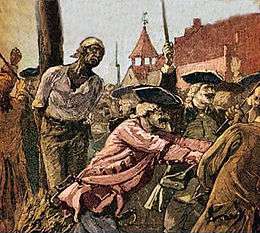Human trafficking in New York
Human trafficking in New York is the illegal trade of human beings for the purposes of reproductive slavery, commercial sexual exploitation, and forced labor as it occurs in the state of New York, and it is widely recognized as a modern-day form of slavery. It includes “the recruitment, transportation, transfer, harboring or receipt of persons by means of threat or use of force or other forms of coercion, of abduction, of fraud, of deception, of the abuse of power, or of a position of vulnerability or of the giving or receiving of payments or benefits to achieve the consent of a person having control over another person, for the purpose of exploitation. Exploitation shall include, at a minimum, the exploitation of prostitution of others or other forms of sexual exploitation, forced labor services, slavery or practices similar to slavery, servitude or the removal of organs.”[1]
According to the 2011 Department of State report, New York, together with California, Texas, and Oklahoma, has the largest concentrations of survivors of human trafficking.[2] The National Human Trafficking Resource Center reported receiving 924 calls and emails in 2015 about human trafficking in New York.[3]
History of slavery

The first slave was brought into New York in 1626. In 1741, the slaves attempted an insurrection, which failed. In 1799, New York passed a law that would eventually release all slaves. The last legal slave was freed in 1827.
Demographics
Exact numbers are difficult to obtain since human trafficking is illegal in New York. However, the National Human Trafficking Resource Center keeps statistics on the number of calls to their hotline and the number of cases. From December 2007 to June 2015, they received 4,121 calls on human trafficking in New York, which resulted in 1,104 cases. The most common type of trafficking was sex trafficking, and domestic work.[4]
Laws
- The New York State Anti-trafficking law was created in 2007. It created the crimes of Labor Trafficking and Sex Trafficking, provides immunity for victims and gives benefits and services to the victims.[5]
- New York State Safe Harbour for Exploited Children Act was created in 2008. It gives exploited children protection from the Family Court and access to services.[6]
Organizations
- New York State Anti-Trafficking Coalition is an umbrella group of more than 140 anti-trafficking organizations, and work towards raising public awareness, pass laws, improve law enforcement, and providing services to victims of human trafficking.[7] Together with Sanctuary for Families it launched New York's New Abolitionists campaign to raise awareness of human trafficking.[8]
- Girls Educational and Mentoring Services (GEMS) is a non-profit organization that provides services to commercially sexually exploited and domestically trafficked girls and young women, typically underage youth exploited by pimps and traffickers. The organization was founded in 1998 by Rachel Lloyd and is based in Harlem, New York City.[9] The organization has helped several hundred young girls transition out of the sex industry and get back to their full potential.[9] They also participated in lobbying for passage of the Safe Harbor Act for Sexually Exploited Youth, which provides that girls under the age of 16, who are arrested in New York for prostitution will be treated as victims, rather than criminals.[10] The bill was signed into law in September 2008.[11] The work of GEMS is the subject of the 2007 documentary Very Young Girls.[12]
References
- ↑ United Nations (2000). "U.N. Protocol to Prevent, Suppress and Punish Trafficking in Persons, especially Women and Children" (PDF). Retrieved March 3, 2012.
- ↑ HIDDEN SLAVES: Forced Labor in the United States (PDF), Human Rights Center, University of California, Berkeley, September 2004, ISBN 0-9760677-0-6, archived from the original (PDF) on 2007-08-30, retrieved 4-5-10 Check date values in:
|access-date=(help) (archived from the original Archived August 30, 2007, at the Wayback Machine. on 2007-08-30) - ↑ "United States Report: 1/1/2015 – 12/31/2015" (PDF). National Human Trafficking Resource Center. National Human Trafficking Resource Center. Retrieved 19 May 2016.
- ↑ National Human Trafficking Resource Center http://www.traffickingresourcecenter.org/state/new-york. Missing or empty
|title=(help) - ↑ New York laws
- ↑ Safe Harbour Project
- ↑ New York state anti-trafficking Coalition
- ↑ New York Human Trafficking
- 1 2 Feldman, Cassi (April 24, 2007), "Report Finds 2,000 of State's Children Are Sexually Exploited, Many in New York City", The New York Times
- ↑ Haberman, Clyde (July 8, 2008), "Helping Girls as Victims, Not Culprits", The New York Times
- ↑ Governor Paterson Signs Law to Protect Sexually Exploited Youth, September 26, 2008
- ↑ Catsoulis, Jeannette (July 4, 2008), "Children Without Childhoods", The New York Times
